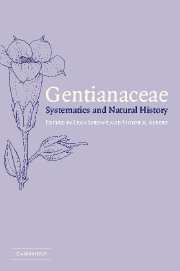Book contents
- Frontmatter
- Contents
- List of contributors
- Foreword
- 1 Gentianaceae in context
- 2 Systematics, character evolution, and biogeography of Gentianaceae, including a new tribal and subtribal classification
- 3 Cladistics of Gentianaceae: a morphological approach
- 4 Gentianaceae: a review of palynology
- 5 The seeds of Gentianaceae
- 6 Chemotaxonomy and pharmacology of Gentianaceae
- Index
6 - Chemotaxonomy and pharmacology of Gentianaceae
Published online by Cambridge University Press: 08 August 2009
- Frontmatter
- Contents
- List of contributors
- Foreword
- 1 Gentianaceae in context
- 2 Systematics, character evolution, and biogeography of Gentianaceae, including a new tribal and subtribal classification
- 3 Cladistics of Gentianaceae: a morphological approach
- 4 Gentianaceae: a review of palynology
- 5 The seeds of Gentianaceae
- 6 Chemotaxonomy and pharmacology of Gentianaceae
- Index
Summary
ABSTRACT
The occurrence of taxonomically informative types of compounds in the family Gentianaceae, namely iridoids, xanthones, mangiferin, and C-glucoflavones, has been recorded. The properties, biosynthesis, and distribution of each group of compounds are described. The iridoids (mainly secoiridoid glucosides) appear to be present in all species investigated, with a predominance of swertiamarin and/or gentiopicroside; c. 90 different compounds have been reported from 127 species in 24 genera. Xanthones are not universally present in Gentianaceae, but about 100 different compounds have been reported from 121 species in 21 genera. A coherent theory for the biosynthesis of xanthones, based partly on published biosynthetic results and partly on biosynthetic reasoning, is postulated and used to group the compounds into biosynthetic categories. Arranging the genera according to the xanthones present gives rise to four groups. Group 1 (Anthocleista, Blackstonia, Gentianopsis, Macrocarpaea, and Orphium) includes the taxa containing only few and biosynthetically primitive xanthones. Group 2 (Comastoma, Gentiana, Gentianella, Lomatogonium, Swertia, and, tentatively, Tripterospermum) contains xanthones with an intermediate degree of biosynthetic advancement. Group 3 (Frasera, Halenia, and Veratrilla) has the most advanced compounds, with the xanthones found in group 2 being the biosynthetic precursors. Group 4 (Canscora, Centaurium, Chironia, Eustoma, Hoppea, Ixanthus, and, with some reservation, Schultesia) contains another set of biosynthetically advanced compounds. A comparison of the above groups with strict consensus trees based on molecular data (trnL intron and matK sequences) and the new classification proposed by Struwe et al. (2002) shows very good correlation.
- Type
- Chapter
- Information
- GentianaceaeSystematics and Natural History, pp. 573 - 632Publisher: Cambridge University PressPrint publication year: 2002
- 17
- Cited by



